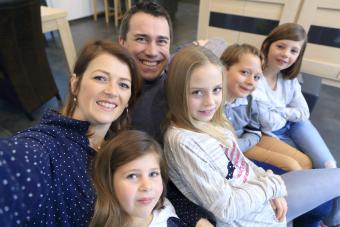
A family and household have overlapping elements. However, they are not the same thing. Learn the key differences to make sure you are using each term correctly.
Definitions of the Difference Between Family and Household
A family is defined as a group of people who are related through legal or blood bonds; they are together through birth, marriage, and/or adoption. Family may include people who do not live under the same roof, such as aunts, uncles, grandparents, and cousins. A household, on the other hand, is one or more people who live in a single residence (house, apartment, condo) but are unrelated. Families can be part of a larger household, and households can include members of several unrelated families who do not reside together.
What Is a Family Unit?
Publications and entities may refer to some groups of people as family units. This is generally used when referring to the number of people in the family. For example, a family unit may be one (an individual) or it could be three or five related persons living together.
Examples of Family Units
Families are comprised of different types of structures. These include:
- Nuclear families - Two parent family with a child or children
- A couple or individual without a child or children
- Single parent families - One parent with one or more children
- Extended families - Includes more distant relations, such as cousins and aunts/uncles
- Grandparent families - Families with grandparents included in the raising and rearing of children
- Step-families/blended families - Marriage and/or births brought two separate families together
These family units may all live together in the same residence, or they may be parts of several residences. For example, a child in a step-family may be part of two different households. Single adults may live with several roommates and be part of their household without being related.

Examples of Household Units
Household units may include entire families or members of several families. The household is a social unit whose individuals may or may not be related to one another. For example:
- Single parent plus two children and a grandparent (both a family and a household)
- College roommates living together in one house (all unrelated)
- College roommates living together in a shared apartment (two siblings and one unrelated friend)
- Senior citizens living in a shared apartment
- Individual or couple who have foster children (plus their own children, if any)
- Boarders/lodgers who rent a room in a larger residence with others
- Coworkers who share the same house or apartment
- Live-in nanny/senior care worker plus the person(s) they care for and their relatives who live in the same home
In these examples, each individual is often a member of a larger family unit, but is part of the same household.
Additional Ways to Discuss Family and Household
The government defines family and household for multiple purposes, from census taking, to taxes, to income assistance. However, there are several other related terms that are used when discussing families and households that are helpful to understand as well.
What Is a Family Household vs Nonfamilial Household?
A family household includes everyone who lives together who are related; no one who is not related lives in that residence. A nonfamilial household includes unrelated people who reside in the same dwelling.

What Is a Single Family Household?
A single family household is one related family living together in the same dwelling. No other persons live there.
What Is a Multigenerational Family Household?
A multigenerational family household is when there are family members who live together with members from several generations. This may include grandparents, great-grandparents, and grandchildren.
Family and Household Dynamics Are Fluid
The meaning of family and household changes as people's living situations and shared bonds change through time. Cultural shifts also impact these definitions. For example, same-sex and opposite-sex couples may be considered as families or households depending on marital status according to the census. Research studies and country-wide surveys have found that the basic definitions and classifications for family types and household units may not encompass all situations as structural changes occur in these traditional institutions. It is important to keep in mind that individuals may define their family and household in their own unique way, rather than by formal definitions. For example, they may consider close friends to be a part of their family.
Household and Family Are Important
Understanding the definitions of families and households can be helpful. While what is considered a family versus a household may have strict definitions according to certain institutions, know that however you uniquely define who is and is not a part of your family is up to you.







